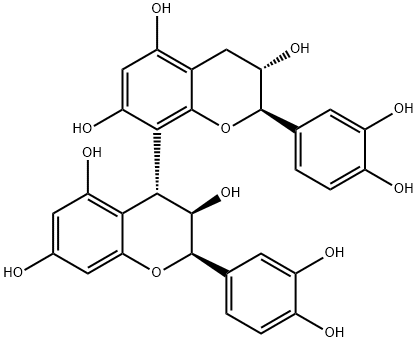20315-25-7

Product Name:
Procyanidin B1
Formula:
C30H26O12
Synonyms:
(−)-Epicatechin (4β-8)-(+)-catechin;cis,trans′′-4,8′′-Bi-(3,3′,4′,5,7-Pentahydroxyflavane);Proanthocyanidin B1
Inquiry
CHEMICAL AND PHYSICAL PROPERTIES
| Physical Description | Solid |
|---|---|
| Melting Point | 231 - 232 °C |
COMPUTED DESCRIPTORS
| Molecular Weight | 578.5 g/mol |
|---|---|
| XLogP3 | 2.4 |
| Hydrogen Bond Donor Count | 10 |
| Hydrogen Bond Acceptor Count | 12 |
| Rotatable Bond Count | 3 |
| Exact Mass | 578.14242626 g/mol |
| Monoisotopic Mass | 578.14242626 g/mol |
| Topological Polar Surface Area | 221 Ų |
| Heavy Atom Count | 42 |
| Formal Charge | 0 |
| Complexity | 925 |
| Isotope Atom Count | 0 |
| Defined Atom Stereocenter Count | 5 |
| Undefined Atom Stereocenter Count | 0 |
| Defined Bond Stereocenter Count | 0 |
| Undefined Bond Stereocenter Count | 0 |
| Covalently-Bonded Unit Count | 1 |
| Compound Is Canonicalized | Yes |
PRODUCT INTRODUCTION
description
Procyanidin B1 is a proanthocyanidin consisting of (-)-epicatechin and (+)-catechin units joined by a bond between positions 4 and 8' respectively in a beta-configuration.. Procyanidin B1 can be found in Cinnamomum verum (Ceylon cinnamon, in the rind, bark or cortex), in Uncaria guianensis (cat's claw, in the root), and in Vitis vinifera (common grape vine, in the leaf) or in peach. It has a role as a metabolite, an EC 3.4.21.5 (thrombin) inhibitor and an anti-inflammatory agent. It is a hydroxyflavan, a proanthocyanidin, a biflavonoid and a polyphenol. It is functionally related to a (-)-epicatechin and a (+)-catechin.